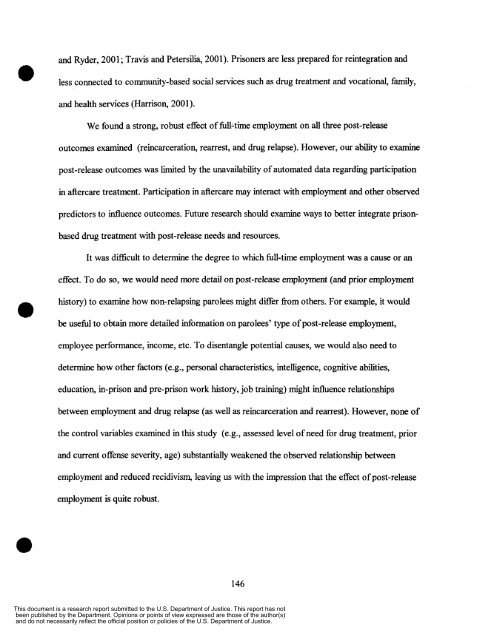0 - National Criminal Justice Reference Service
0 - National Criminal Justice Reference Service
0 - National Criminal Justice Reference Service
You also want an ePaper? Increase the reach of your titles
YUMPU automatically turns print PDFs into web optimized ePapers that Google loves.
and Ryder, 2001; Travis and Petersilia, 2001). Prisoners are less prepared for reintegration and<br />
less connected to community-based social services such as drug treatment and vocational, fdy,<br />
and health services (Harrison, 2001).<br />
We found a strong, robust effect of fUllLtime employment on all three post-release<br />
outcomes examined (reincarceration, rearrest, and drug relapse). However, our ability to examhe<br />
post-release outcomes was limited by the unavailability of automated data regarding participation<br />
in aftercare treatment. Participation in aftercare may interact with employment and other observed<br />
predictors to influence outcomes. Future research should examine ways to better integrate prisonbased<br />
drug treatment with post-release needs and resources.<br />
It was dif5cult to determine the degree to which hll-time employment was a cause or an<br />
a<br />
effect. To do so, we would need more detail on post-release employment (and prior employment<br />
history) to examine how non-relapsing parolees might differ fiom others. For example, it would<br />
be usehl to obtain more detailed information on parolees’ type of post-release employment,<br />
employee performance, income, etc. To disentangle potential causes, we would also need to<br />
determine how other factors (e.g., personal characteristics, intelligence, cognitive abilities,<br />
education, in-prison and pre-prison work history, job training) might influence relationships<br />
between employment and drug relapse (as well as reincarceration and rearrest). However, none of<br />
the control variables examined in this study (e.g., assessed level of need for drug treatment, prior<br />
and current offense severity, age) substantially weakened the observed relationship between<br />
employment and reduced recidivism, leaving us with the impression that the effect of post-release<br />
employment is quite robust.<br />
146<br />
This document is a research report submitted to the U.S. Department of <strong>Justice</strong>. This report has not<br />
been published by the Department. Opinions or points of view expressed are those of the author(s)<br />
and do not necessarily reflect the official position or policies of the U.S. Department of <strong>Justice</strong>.
















